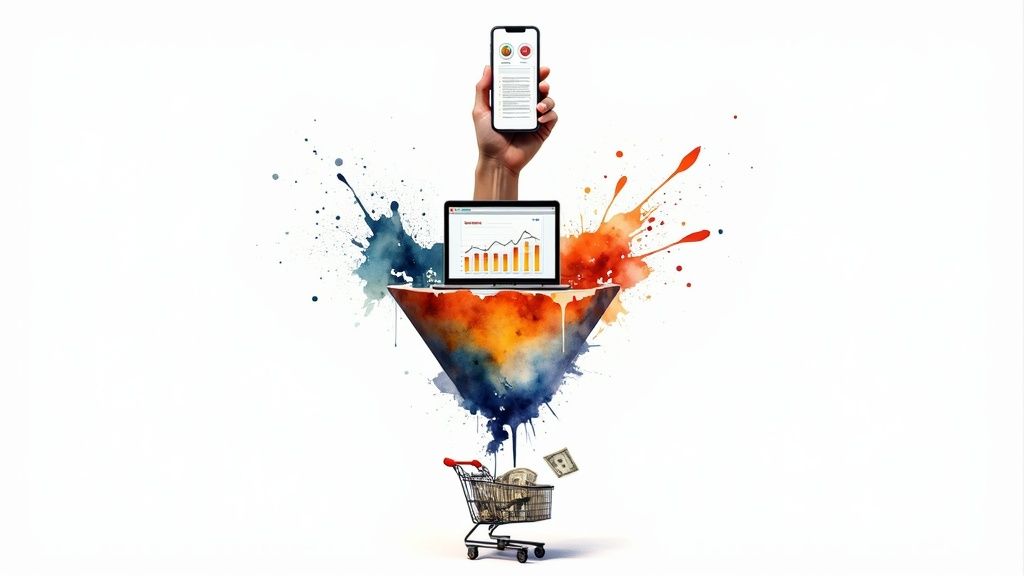A great Facebook Ads funnel is more than just a string of random ads. It’s a carefully crafted customer journey. The goal is to guide people from "who are you?" to "take my money!", turning complete strangers into your biggest fans by showing them the right message at exactly the right time.
Laying the Strategic Groundwork for Your Funnel
Think of your funnel as the blueprint for how a customer finds and buys from you. Flying without one means you’re just chucking ads out there, hoping one will magically work. That’s a fast track to draining your ad budget. A solid plan stops that from happening by making sure every ad has a purpose.
Before you even touch Facebook Ads Manager, you need a high-level view of what a sales funnel actually is. Getting the basics of how to create a sales funnel is critical. This knowledge ensures your ads are part of a bigger, smarter plan, not just random shots in the dark.
It all starts with getting crystal clear on your goals. What do you really want to achieve? The answer to that question shapes your entire funnel and every campaign you run.
Defining Your Funnel Stages
The classic marketing funnel is a simple but incredibly effective way to structure your Facebook ads. Each stage targets people with a different level of awareness, so your approach needs to change for each one.
Top of Funnel (ToFu) - Awareness: This is where you introduce your brand to a cold audience—people who have probably never heard of you. Your job is to educate and provide value, not to sell. Think blog posts, helpful videos, or free guides.
Middle of Funnel (MoFu) - Consideration: Now you’re talking to a warm audience, people who’ve clicked a link, watched a video, or visited your site. They know who you are. Your mission here is to build on that initial interest, nurture trust, and show them why you're the best option.
Bottom of Funnel (BoFu) - Conversion: This is your hot audience. They’re on the verge of buying. You just need to give them a final nudge. Think compelling offers, testimonials, and clear calls-to-action that scream "buy now!"
I see this mistake all the time: people trying to sell to a cold audience right at the top of the funnel. It's like proposing on a first date. You have to build that awareness and trust first before you can ask for the sale. It almost never works otherwise.
This chart paints a pretty clear picture of how conversion rates can swing wildly between the different funnel stages.
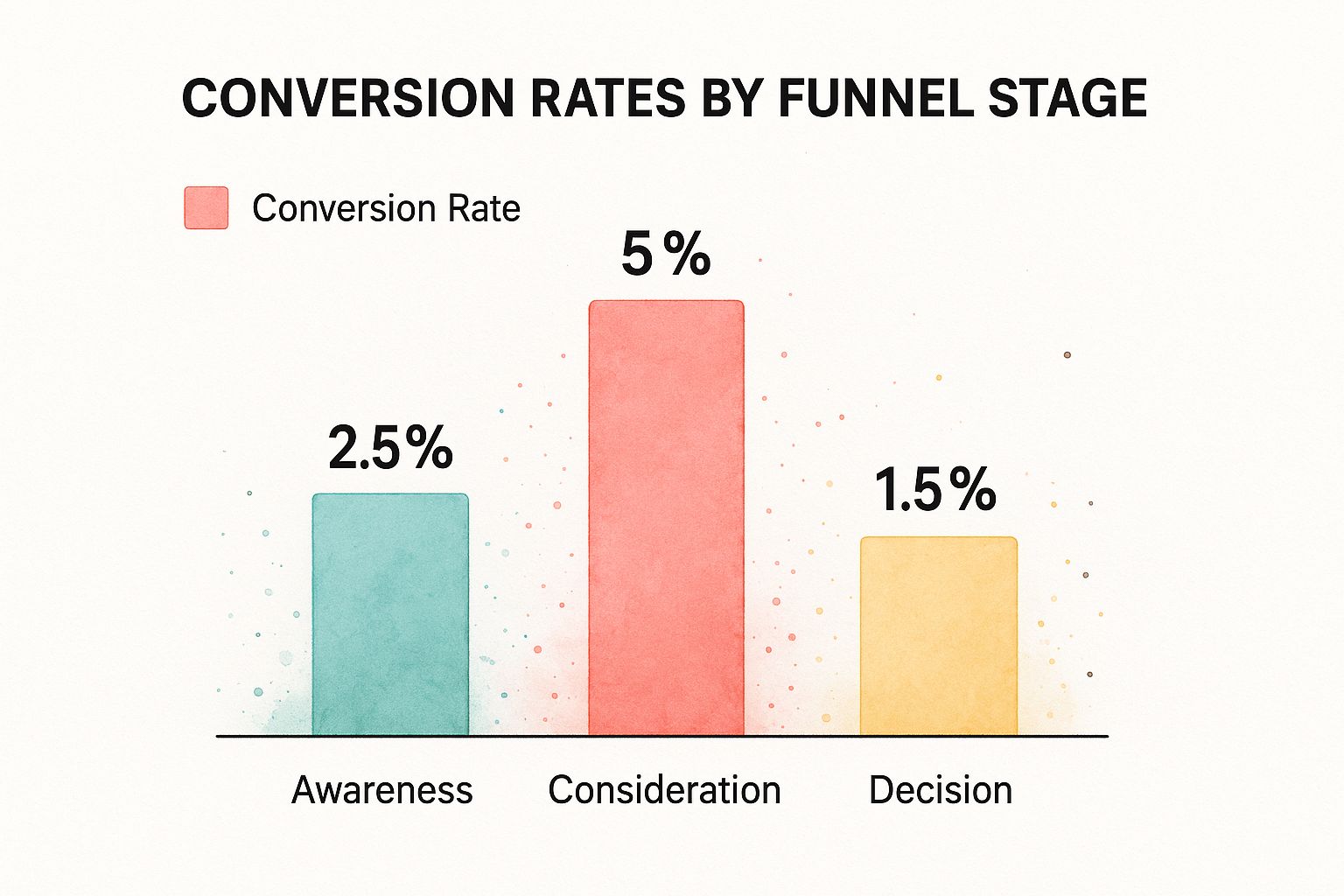
As you can see, the consideration stage is often where the magic happens with conversions. This just hammers home how important it is to properly warm up your leads.
The Essential Technical Setup
A brilliant strategy is just a nice idea without the right tech to back it up. There are two pieces of the puzzle that are absolutely non-negotiable for running effective Facebook Ads funnels.
First up is the Meta Pixel. This is a small snippet of code you install on your website. It’s your eyes and ears, tracking what visitors do on your site. This lets you see what’s working, build powerful custom audiences for retargeting, and let Meta's algorithm optimize for actual conversions. Running ads without the Pixel is like trying to drive with a blindfold on.
Working hand-in-hand with the Pixel is the Conversions API (CAPI). This creates a more direct, server-to-server connection with Meta's systems. Why does that matter? It helps you get around data loss from things like iOS updates and ad blockers, making your tracking far more reliable. Using both the Pixel and CAPI together is the gold standard for accurate data.
To see how all these pieces fit into a broader growth strategy, you'll find tons of practical advice over on our Rebel Growth blog.
Finally, let's talk about some real-world benchmarks to keep in mind. Industry data suggests a click-through rate (CTR) of 1% or higher is a decent starting point for most Facebook Ads. For lead generation campaigns, which are the heart and soul of your middle funnel, aiming for a CTR between 2% and 3% is a solid goal to shoot for.
Capturing Attention With Top Of Funnel Campaigns
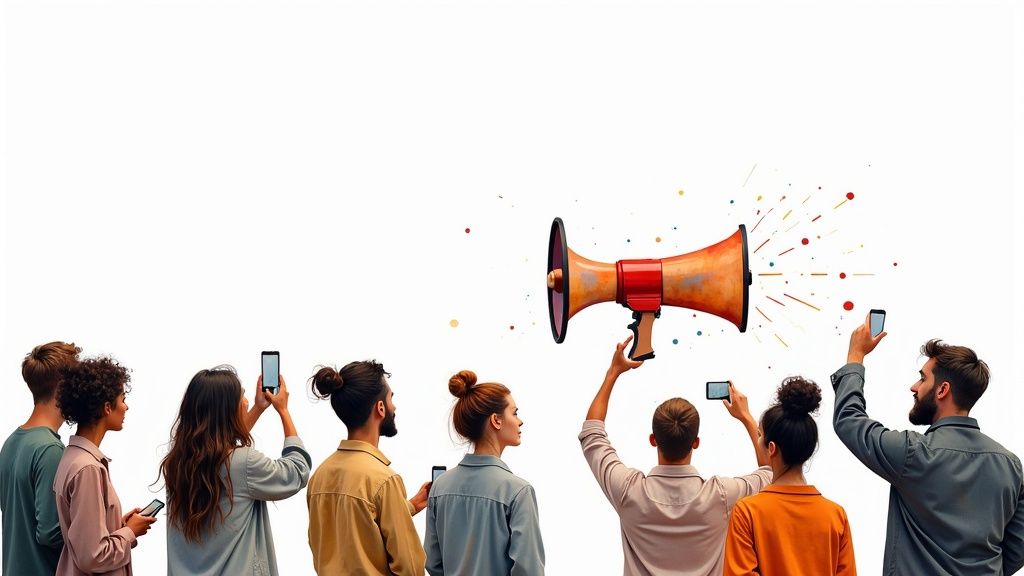
This is where your brand makes its first impression. At the Top of Funnel (ToFu), you're speaking to a cold audience—people who likely have no clue who you are. Going straight for the sale here is one of the fastest ways to burn through your ad budget.
Instead, the mission is all about building awareness and starting to earn trust. Think of it as walking into a room and starting a friendly conversation, not shouting "Buy my stuff!" Your goal is to provide genuine value, making people curious enough to want to learn more. The key is to educate, entertain, or inform without asking for anything in return just yet.
Crafting The Right Content
Your ToFu content needs to be broad, engaging, and genuinely useful. This isn't the place to talk about product features. It’s about tackling the problems, questions, and interests of your target audience head-on. You want to create something that stops their scroll and makes them think, "Huh, that's interesting."
Here are a few content formats that consistently kill it at this stage:
- Engaging Video Ads: Short, dynamic videos that tell a quick story or share a useful tip are gold. For example, a skincare brand could run a 30-second video on "3 Morning Habits for Glowing Skin" without ever mentioning a specific product.
- Insightful Blog Posts: Driving traffic to a well-written article that solves a common pain point is a classic ToFu play. A company selling financial software might advertise a post like, "5 Simple Budgeting Mistakes and How to Fix Them."
- Useful Checklists or Guides: Offering a free downloadable resource provides immediate value and gets your foot in the door. A home organization brand could offer a free "Ultimate Spring Cleaning Checklist" to capture initial interest.
The common thread? Value first. You're positioning your brand as a helpful expert, not a pushy salesperson. This builds the goodwill you need to guide people further down your Facebook Ads funnels.
I’ve seen countless businesses try to run direct-response, "buy now" ads to a cold audience. They almost always fail. You have to earn the right to sell to someone. ToFu is your chance to make a great first impression by being helpful.
Choosing Your Campaign Objective
Inside Facebook Ads Manager, your campaign objective has to match your ToFu goals. You aren't optimizing for purchases at this point. Instead, you'll pick objectives that prioritize getting in front of as many new faces as possible.
The best choices for Top of Funnel campaigns are:
- Awareness: This objective is built to show your ads to the maximum number of people in your audience, getting your brand name out there.
- Traffic: Use this when your goal is to send people to your content off-Facebook, like a blog post or a landing page with that free guide.
- Engagement: If your ad is a video or a post designed to spark conversation, this objective will optimize for views, comments, shares, and likes.
So, if you're promoting that skincare video, you’d probably choose the Awareness or Engagement (specifically for video views) objective. Your key metrics won't be sales; they'll be things like Reach, Impressions, and Video ThruPlays.
Configuring Your Audience Targeting
Since you're talking to a cold audience, this is where you lean on Facebook's incredible targeting tools to find new people who look like your ideal customer. You won't be using Custom Audiences from your Pixel data yet. That comes later.
Instead, you’ll build audiences based on:
- Interest Targeting: This is your bread and butter for ToFu campaigns. You can target people based on the pages they've liked, groups they're in, and topics they engage with. A company selling sustainable coffee could target interests like "Fair Trade Coffee," "Whole Foods Market," and "Sustainable Living."
- Demographic Targeting: Layer in basics like age, gender, location, and language to make sure you're talking to the right general group.
- Lookalike Audiences: While often used in the middle of the funnel, a very broad Lookalike Audience (think 5-10%) based on your existing customer list can be a killer way to find new, similar people at scale.
The strategy here is to cast a wide but intelligent net. You're introducing your brand to a huge pool of potentially interested people. By combining value-packed content with the right campaign objectives and broad targeting, you create a powerful entry point into your Facebook Ads funnels that perfectly sets the stage for what comes next.
Nurturing Leads Through The Middle Of Funnel
Alright, you’ve grabbed their attention at the top of the funnel. Now what? This is where the real work begins. We’re moving into the Middle of the Funnel (MoFu), and our entire game plan shifts from getting seen to getting known.
This stage is all about nurturing the warm audience you've built. These are the folks who’ve already shown some interest. They’ve watched your videos, clicked through to your site, or engaged with a post. They know who you are, but they're not sold just yet.
Your job is no longer to be a stranger shouting in a crowd. Now, you need to become a trusted guide. The goal is to prove your value, build serious credibility, and firmly plant your brand as the go-to solution for their problems. We do this with smart retargeting, hitting them with high-value content that speaks directly to their needs and inches them closer to making a purchase.
Building Your Warm Custom Audiences
The magic of the MoFu stage is its precision. We're not guessing anymore. We're talking directly to people who have already raised their hand and shown they’re interested. We accomplish this by creating Custom Audiences inside Meta Ads Manager, zeroing in on users based on the exact actions they've taken.
Don't just lump everyone into one big "warm" bucket. You need to segment your audience based on their level of intent, because not all engagement is created equal.
Here are a few essential Custom Audiences you should set up right away:
- Website Visitors: This is your foundation. You can target everyone who has visited your site, but the real power comes from getting specific. Think about creating audiences for people who visited key service or product pages—that’s a much stronger signal.
- Video Viewers: This is one of my favorite audiences to build. Target people who watched a significant chunk of your top-of-funnel videos, like 50% or 75%. Anyone who sticks around that long is clearly more invested than someone who just scrolled past.
- Facebook/Instagram Page Engagers: This is a great catch-all for anyone who has liked, commented, shared, or saved one of your posts. It also includes people who have visited your profile, sending a clear signal of curiosity.
Segmenting your audiences this way lets you tailor your message with incredible accuracy. The ad you show someone who watched a 3-minute video to the end should be very different from the one you show someone who bounced from your homepage in five seconds.
Deploying High-Value Nurturing Content
Once you have your Custom Audiences ready, it's time to serve them content that builds trust and showcases your expertise. Your ads at this stage should offer real, tangible value that helps prospects dig deeper and evaluate their options. We're still holding back on the hard sell—the focus here is on education, solving mini-problems, and building their confidence in your brand.
Put yourself in their shoes. Their curiosity was piqued. What do they need next? They need more proof, more details, and more reasons to believe you're the right choice.
The content you use in the middle of the funnel is the bridge. It connects the initial problem awareness you created at the ToFu stage to the final purchase decision at the BoFu stage. This is your chance to answer their unasked questions and handle objections before they even think of them.
Some of the most effective types of MoFu content include:
- In-Depth Guides or Ebooks: Offer a comprehensive resource that solves a specific problem related to the content they already engaged with.
- Webinar or Event Invitations: Invite them to a live training where you can deliver a ton of value and interact with them directly. It’s a powerful way to build a connection.
- Case Studies and Testimonials: This is all about social proof. Show them how you've helped people just like them solve the exact problem they're facing. Let your happy customers do the selling for you.
Selecting The Right Campaign Objectives
For your MoFu campaigns, you’ll be moving on from the broad Awareness objectives. The mission now is to generate qualified leads and drive meaningful engagement. The two best campaign objectives for this are Leads and Engagement.
The Leads objective is perfect when you’re offering something in exchange for an email, like a downloadable guide, a checklist, or a webinar registration. You can use Meta's native Instant Forms to capture their info right there on the platform, which makes the process incredibly smooth for the user.
The Engagement objective is still incredibly useful, especially for promoting video case studies or testimonials. It ensures that your most powerful social proof gets maximum visibility with your warm audiences.
As these users engage with your MoFu content—downloading your guide or signing up for your webinar—they're sending even stronger signals of intent to Meta's algorithm. They are essentially graduating to the Bottom of the Funnel, where you can finally, and confidently, ask for the sale. A huge part of making this work is having landing pages that are built to convert this warm traffic. To learn more, check out our guide on creating effective landing pages.
Driving Sales At The Fottom Of Funnel
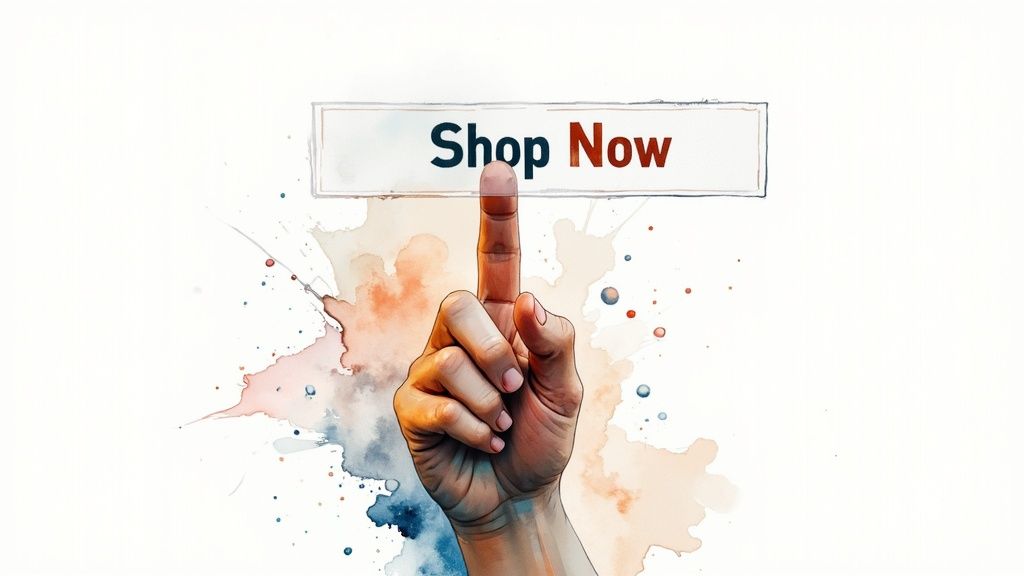
This is the moment of truth. Down here at the Bottom of the Funnel (BoFu), you're not talking to strangers anymore. You're speaking directly to your hot audience—people who are right on the edge of buying. They’ve checked out your pricing, added products to their cart, or spent serious time on key product pages.
Your goal is singular and crystal clear: drive conversions. You've already built the foundational trust in the earlier stages. Now it’s time to give them that final, compelling nudge to act. This means your ad campaigns have to be direct, persuasive, and completely dialed in for sales.
Mastering High-Intent Retargeting
Your most valuable audiences at this point are the ones who have shown undeniable purchase intent. Forget the broader groups you were targeting in the middle of the funnel. It's time to get hyper-specific with your Custom Audiences.
The whole game here is about creating small, tightly focused segments of users who have taken high-value actions. Think about it: someone who just added an item to their cart is worlds more likely to convert than someone who just glanced at your homepage.
Here are the key BoFu Custom Audiences you need to build:
- Cart Abandoners: These are people who added products to their cart but never finished the purchase. This is your lowest-hanging fruit, period.
- Checkout Initiators: Users who went a step further and started the checkout process but bailed before paying.
- Pricing Page Visitors: A massive buying signal for service-based businesses. This audience is actively weighing the cost of your offer.
- Viewed Specific Product/Service Pages: Retargeting based on the exact items they looked at lets you get incredibly personal with your ads.
Segmenting these audiences allows you to tailor your messaging with surgical precision. When you do it right, your ads feel less like ads and more like helpful reminders.
Deploying The Right Ad Formats And Offers
At this final stage, your ads need to do one thing: close the deal. Generic brand messaging just won't cut it anymore. Your creative and copy must work in tandem to crush any final hesitations and prompt immediate action. This is where powerful ad formats and irresistible offers shine.
For any e-commerce store, Dynamic Product Ads (DPA) are your absolute best friend. These ads are magic—they automatically show people the exact products they viewed or added to their cart. It's the ultimate personalized retargeting, reminding them of what they were just about to buy.
No matter your business type, social proof is non-negotiable here. Ads featuring customer testimonials, star ratings, or logos of well-known clients can provide that last little push of confidence a prospect needs to commit.
A common mistake I see is keeping the messaging too soft at this stage. Your audience is ready. Be direct. State the offer clearly, hammer home the benefit, and tell them exactly what to do next. "Shop Now," "Get Your 20% Off," or "Claim Your Free Trial" should be front and center.
This is also the perfect time to introduce a little scarcity and urgency—when used ethically, of course. Phrases like "Limited Stock Remaining" or "Offer Ends Tonight" can be incredibly effective when they're true. These tactics give prospects a reason to act now instead of putting it off.
Check out this proven formula for a cart abandonment campaign:
| Element | Example for an Online Shoe Store |
|---|---|
| Ad Format | Dynamic Product Ad (DPA) |
| Headline | Still Thinking It Over? |
| Ad Copy | Looks like you left something behind! Your perfect pair of shoes is waiting. Complete your order now and get free shipping. |
| Offer | Free Shipping (or a small discount, like 10% off) |
| Call-to-Action | Shop Now |
Optimizing For Sales And Maximizing ROAS
When you're setting up your BoFu campaigns in Ads Manager, your objective is simple: Sales. This signals to Meta's algorithm to hunt down the people in your custom audience most likely to complete a purchase, using all that rich data your Pixel has been collecting.
The performance of these campaigns lives and dies by your data. This is where a reliable Meta Pixel and Conversions API setup truly pays for itself. Solid tracking ensures Meta can accurately identify who's converting and then find more people just like them.
It's encouraging to know that Facebook Ads have an impressive average conversion rate of around 9.2%, making it one of the top-performing social ad platforms. Some industries, like fitness and education, can see even higher rates, often clearing 14%. You can dig into more of these impressive Facebook conversion statistics on amraandelma.com.
Ultimately, your north-star metric for success at the bottom of your Facebook ads funnels is Return On Ad Spend (ROAS). While things like CPC and CTR are still useful health-checks, ROAS tells you the real story: for every dollar you put in, how many are you getting back? A positive ROAS means your funnel is profitable and ready to scale.
Right, so you've launched your Facebook Ads funnels. Getting everything live is a huge first step, but this is where the real work—and the real profit—begins.
Think of your live funnel as a starting point, not a finished product. The path to serious profitability is all about relentless testing, sharp analysis, and smart optimization. If you're not digging into the data to refine your approach, you're just leaving money on the table.
This is how you turn a basic advertising sequence into an efficient, cash-generating machine. By really understanding your metrics, you can spot the weak links in your funnel, double down on what’s crushing it, and scale your wins without breaking your campaigns.
Interpreting Your Funnel's Performance
The first piece of the puzzle is learning to read the story your data is telling you. Your Meta Ads Manager dashboard is flooded with metrics, but you only need to focus on a few key ones at each stage to make good decisions. Don't let it overwhelm you.
For example, at the Top of Funnel (ToFu), a low Click-Through Rate (CTR) is a huge red flag. It usually means your creative or copy just isn't compelling enough to stop the scroll.
Move down to the Middle of Funnel (MoFu). Are you seeing a high CTR but your landing page conversions are in the gutter? That points to a disconnect. Your ad is making a promise that your landing page isn't keeping.
And at the Bottom of Funnel (BoFu), a classic problem is a high Add to Cart rate but a low purchase rate. This often signals a problem with your checkout process—maybe it's too complicated, or perhaps your pricing or shipping costs are causing sticker shock.
A common trap is getting hung up on vanity metrics like impressions or reach. Sure, they’re useful for awareness, but they don't tell you if your funnel is actually making you money. The single most important metric across the entire funnel is your Return On Ad Spend (ROAS). If your ROAS is positive, you're profitable. Simple as that.
The Power of A/B Testing
You should never, ever assume you know what will work best. A/B testing (or split testing) is the engine of optimization. It’s a straightforward process: run two or more versions of an ad against each other and let the data tell you which one wins. This completely removes guesswork from the equation.
The key is to test one variable at a time. If you change the image, the headline, and the body copy all at once, you’ll have no idea which change actually moved the needle. Keep it clean to get actionable results.
Start by testing these big-impact elements:
- Creatives: Pit a video ad against a slick static image. Or, try different images that spotlight different product benefits or use cases.
- Ad Copy: Experiment with different headlines. Test short, punchy copy against a longer, more story-driven version.
- Audiences: Run a Lookalike Audience against an interest-based audience to see which one delivers a better cost per result.
Going beyond just the funnel itself, mastering broader top conversion rate optimization strategies is essential for squeezing every last drop of performance out of your campaigns. This knowledge helps you fine-tune every single touchpoint.
Scaling Your Winning Campaigns
Once you’ve tested your way to a winning ad—a campaign that’s delivering a consistent, healthy ROAS—it's time to scale. Scaling just means carefully increasing your budget to get more of those fantastic results. But be warned: doing this the wrong way can completely tank a campaign's performance.
There are two main ways to go about it:
Vertical Scaling: This is the most direct method. You just gradually increase the daily budget of your best-performing ad set. The key word here is gradually. Big, sudden budget jumps can shock the algorithm and throw it right back into the learning phase. A solid rule of thumb is to increase the budget by 15-20% every 2-3 days, but only if performance holds steady.
Horizontal Scaling: This is where you duplicate your successful ad set and point it at a new, similar audience. For instance, you could take a winning ad set and test it with a different Lookalike Audience percentage (like expanding from a 1% Lookalike to a 1-3% Lookalike) or a completely new set of interests.
Many of the top marketing teams we've seen use a mix of both. We've watched this disciplined approach transform the growth trajectory for the https://rebelgrowth.com/companies we work with at Rebel Growth, turning steady results into exponential gains.
It all comes down to a disciplined, data-first mindset.
Your Funnel Optimization Checklist
To help you diagnose issues and find opportunities, here’s a practical checklist. Use it to systematically review performance at each stage of your funnel.
| Funnel Stage | Metric to Check | Potential Problem | Optimization Tactic |
|---|---|---|---|
| Top of Funnel (ToFu) | Low CTR (<1%) | Ad creative or copy is not engaging. | A/B test new images, videos, headlines, and hooks. |
| High CPM | Audience is too competitive or small. | Broaden audience targeting; test new interest groups. | |
| Middle of Funnel (MoFu) | High CTR, Low Conversion Rate | Mismatch between ad and landing page. | Ensure landing page headline/offer mirrors the ad. Improve page speed and mobile experience. |
| Low Video View Rate | Video is not holding attention. | Front-load value in the first 3 seconds. Add compelling captions. | |
| Bottom of Funnel (BoFu) | High Add to Cart, Low Purchase Rate | Checkout friction or sticker shock. | Simplify the checkout process. Offer a tripwire discount or address shipping costs. |
| Low ROAS | Offer isn't profitable at current CPA. | Test new offers (e.g., bundles, payment plans). Optimize for higher-value conversions. |
This checklist isn't exhaustive, but it's a fantastic starting point for any campaign audit. Regularly walking through these points will help you build a truly powerful and profitable Facebook Ads funnel.
Common Questions About Facebook Ads Funnels
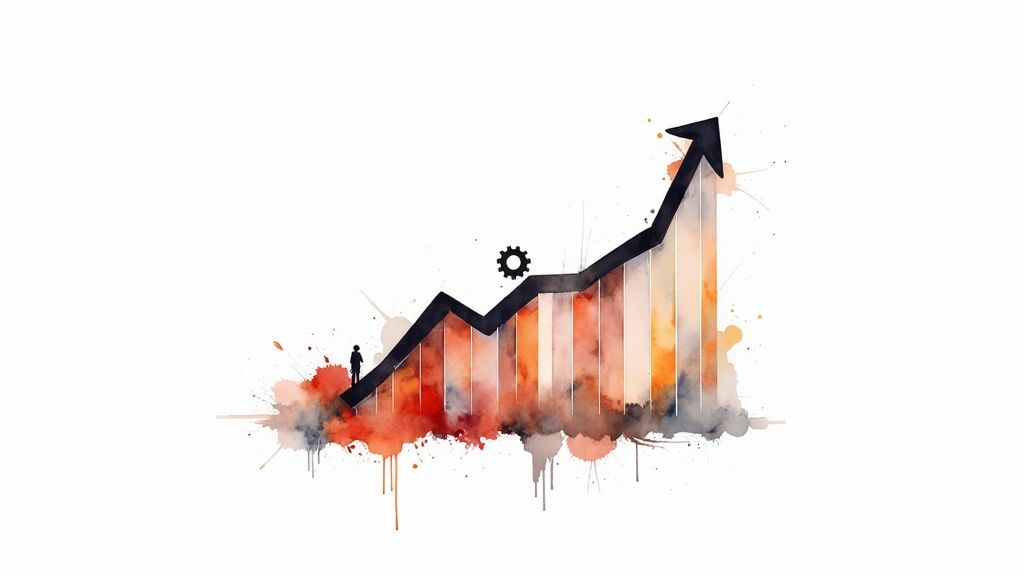
Even with a rock-solid strategy, you’re going to have questions once you're in the trenches running Facebook Ad funnels. It's just part of the process.
Getting straight answers to the usual hurdles can mean the difference between a campaign that fizzles out and one that actually makes you money. Let's dig into the questions I hear the most.
How Much Should I Budget For My Ads Funnel?
This is the big one, but there's no single magic number. The right budget really comes down to your industry, what you're trying to achieve, and the size of your audience.
That said, a good, practical starting point for testing is $10–$20 per day for each of your campaigns—Top of Funnel, Middle of Funnel, and Bottom of Funnel.
The game plan here is simple: start small. This lets you gather that all-important performance data and figure out which ads are your winners. Once you find a campaign that's delivering a solid Return On Ad Spend (ROAS), then you can confidently start scaling up your budget. Always focus on profitability before you just throw more money at it.
How Long Until A Facebook Funnel Starts Working?
Patience is a virtue, especially here. As soon as you launch a new campaign, Facebook’s algorithm kicks into a "learning phase." This usually takes about three to seven days. During this window, it's crunching data, trying to figure out the absolute best way to show your ads to the right people.
You might see a few glimmers of hope in that first week, but don't get too excited just yet. A really clear picture of how your funnel is performing typically takes around two to four weeks to materialize. This gives the algorithm enough time and data to work its magic, and it gives you enough reliable info to make smart calls on what to optimize and what to scale.
What Are The Most Common Mistakes To Avoid?
I’ve seen a lot of well-intentioned funnels completely fall apart because of a few common, avoidable mistakes. If you can steer clear of these, you’re already ahead of the game.
- Selling Too Soon: This is the classic blunder. You can't just ask a cold audience for a sale on the first date. You have to build awareness and earn their trust first.
- One-Size-Fits-All Creative: Running the same ad creative and copy across the entire funnel just doesn't work. Your message needs to evolve as your audience moves from one stage to the next.
- Ignoring the Meta Pixel: A broken or missing Pixel is a campaign killer. It means no accurate tracking, no effective retargeting, and you're starving the algorithm of the conversion data it needs to optimize.
- Quitting Too Early: So many advertisers get nervous and pull the plug before the learning phase is even over. You have to give your campaigns a fair shot to find their footing.
- Failing to A/B Test: If you aren’t constantly testing different ad variations, audiences, and creative, you’re just guessing. You're leaving money on the table, plain and simple.
The two most powerful tools you have are patience and data. Rushing things or ignoring what the numbers are telling you is the fastest way to blow your budget and get frustrated. Let the data be your guide.
Should I Use Lookalike Audiences Or Interest Targeting?
This isn't an either/or question. The real answer is: you should use both, but at different stages of the funnel where they can have the most impact.
Interest-based targeting is your best friend for Top of Funnel (ToFu) campaigns. It's the perfect way to get in front of totally new audiences—people who've never heard of you but have shown interest in things related to what you offer.
Lookalike Audiences, on the other hand, are absolute gold for both ToFu and MoFu. You create them by feeding Facebook a source audience, like your existing customer list or people who have purchased from your website. Facebook then goes out and finds new people who share similar characteristics. It’s a fantastic way to find high-quality prospects at scale.
Unlock your brand's full potential with rebelgrowth. Our all-in-one platform combines AI-powered content creation, backlink networking, and social media management to drive targeted traffic and accelerate your growth. Start building a smarter marketing engine today at https://rebelgrowth.com.
